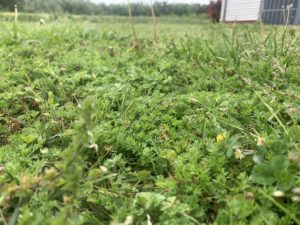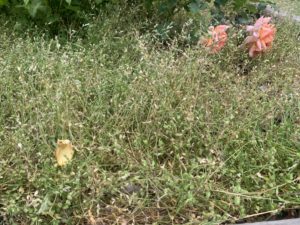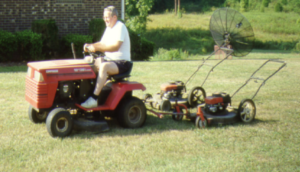Got Weeds…Here’s Some Sharp Advice!
go.ncsu.edu/readext?683276
en Español / em Português
El inglés es el idioma de control de esta página. En la medida en que haya algún conflicto entre la traducción al inglés y la traducción, el inglés prevalece.
Al hacer clic en el enlace de traducción se activa un servicio de traducción gratuito para convertir la página al español. Al igual que con cualquier traducción por Internet, la conversión no es sensible al contexto y puede que no traduzca el texto en su significado original. NC State Extension no garantiza la exactitud del texto traducido. Por favor, tenga en cuenta que algunas aplicaciones y/o servicios pueden no funcionar como se espera cuando se traducen.
Português
Inglês é o idioma de controle desta página. Na medida que haja algum conflito entre o texto original em Inglês e a tradução, o Inglês prevalece.
Ao clicar no link de tradução, um serviço gratuito de tradução será ativado para converter a página para o Português. Como em qualquer tradução pela internet, a conversão não é sensivel ao contexto e pode não ocorrer a tradução para o significado orginal. O serviço de Extensão da Carolina do Norte (NC State Extension) não garante a exatidão do texto traduzido. Por favor, observe que algumas funções ou serviços podem não funcionar como esperado após a tradução.
English
English is the controlling language of this page. To the extent there is any conflict between the English text and the translation, English controls.
Clicking on the translation link activates a free translation service to convert the page to Spanish. As with any Internet translation, the conversion is not context-sensitive and may not translate the text to its original meaning. NC State Extension does not guarantee the accuracy of the translated text. Please note that some applications and/or services may not function as expected when translated.
Collapse ▲Sharp Advice to Follow!
My wife and I have just moved into a new home. There are so many things to do! There is unpacking, organizing, remodeling, and not to mention getting the lawn in order. I have been so busy on the first few things that I failed to realize, we have a huge, I mean HUGE lawn burweed problem. I say problem because once you notice it in the Spring of the year, there is very little that can be done about it. I give this advice every year but I usually do not have to follow it! I have four children that range in age from three to thirteen, that’s a lot of prickles in the feet for momma to fix! A little preparation and timely work will go a long way in helping with this problem.
Lawn burweed is a winter annual weed that grows unnoticed until the spiny seed begins to form in the Spring. This weed germinates in the fall, lies mostly dormant through the winter, and then grows like crazy when the weather gets warm in the spring. It grows prostrate along the ground so mowing is largely ineffective. By the time the spiny seeds come out, the plant is nearly through its life cycle for the year. At this point, herbicides are completely ineffective as well.
There are a few things you can do, however, perhaps a little unorthodox and certainly not University researched, unbiased information, just good old-fashioned common sense! Get a real fuzzy blanket and a couple of cinder blocks (these can be used for exercise too under this quarantine). Fasten the blanket to your lawnmower and then place the bricks on top of the blanket. Ride over the lawn burweed, or pull the blanket along by hand and the blanket will pick up many of the seeds. This does two things, keeps the seeds from replenishing the soil seed bank and keeps those feet from being harmed!
If you really want to get rid of lawn burweed then you should use a pre-emergent herbicide in September to mid-October to get it under control. This will keep the seed of this plant, and many other grass and broadleaf winter annual weeds, from being able to germinate in the first place. A follow-up application of a post-emergent herbicide may be necessary to get the weeds under control. This would be applied in mid-December of the same year. In my case, we could host a weed identification class here at our new house! I will most likely need to have a follow-up application this year. Once the weeds are under control, these herbicide applications should not continue to be necessary every year.
Be sure to research and select an herbicide that works with your turf. Read the entire label to make sure you are wearing the proper personal protective equipment, mixing the chemical correctly, applying the chemical correctly, and to make sure when it is safe for children and pets to return to the application area. Oh, by the way, it is important to make sure the herbicide you are using kills the weeds you have! Don’t waste your money and time on something that isn’t labeled for your weeds!
The best way to protect your lawn from weed intruders, however, is to promote a healthy stand of turf. Fertilize your soil according to an N.C. Department of Agriculture and Consumer Services soil test every year. A soil test, taken every third year, is sufficient for your lawns’ needs and recommended application of lime.
Perhaps the most important thing you can do, on a regular basis though, is to mow your grass at the correct height. Warm-season grasses are so sensitive to shade that if they are allowed to grow too tall, they will actually shade themselves out. This is very stressful for the turf and makes it look like you are scalping the grass nearly every time you mow. Upon closer inspection, the grass will only be green on the very top resembling a miniature tree. Most warm-season grasses like to be kept in the 1” – 2” height with the exception being St. Augustine grass. This grass performs really well if kept between 2.5” – 3.5”.
To bust one lawn myth, not bagging your clippings is not a key contributor to thatch! If mowing at the proper height with the proper timing (cutting 1/3 of the total height of the grass), leaving the clippings on your lawn can contribute as much as 25% of your lawn’s Nitrogen needs for the season. However, allowing your grass to be too tall is one of the biggest contributors to thatch. Thatch is a build-up of dead plant material that can harbor insects, promote disease, and prevent gas exchange in the soil. If thatch build-up is over 3/4 of an inch, it is time to dethatch the lawn.
If you have a question about the mowing height of your grass, the Carolina Lawns publication available from NC State University spells it out for each turf type. This publication also has information on establishing, restoring, and maintaining your grass. There is a comparison chart of each of the cool and warm-season grasses with cultural recommendations such as mowing height and fertilizer amounts (rule of thumb, but not a replacement for a soil test). You can find the publication online or get a hard copy at your local extension center (just make sure to call ahead right now while we are under COVID-19 restrictions.
Lastly, there are the Lawn Maintenance Calendars that can be found at TurfFiles. These files have a quarterly schedule for what you can be doing to promote a healthy stand of turf at your home. TurfFiles is an NC State University website that has information on grasses, weeds, diseases, and insects that can be found specifically in turf. NC State University is known on the world’s stage for its turf website and turf research information. Each of the turf issues is complete with cultural and chemical controls. Using both control methods for your issue will ensure greater success!
So, after the summer, when the weather begins to turn cool once again, remember – it is time to take care of that lawn burweed as well as other cool-season annuals!
I have really good news to report for all of those folks who have been waiting for the NCDA&CS Agronomy lab to open back up, they are now excepting routine samples! The turn-around time may be a bit longer due to reduced staffing but we can now send samples into the lab. So, if you have been waiting to get your samples in, now is the time!






